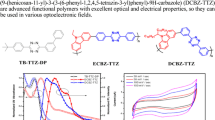Abstract
The optical and electrical properties of a novel alcohol soluble aminoalkyl-substituted cationic conjugated polymer, poly[9,9′-bis(6″-(N,N,N-trimethylammonium)-hexyl)fluorene-co-alt-2,5-dimethoxy-1,4-phenylene dibromide] (PFPB), has been studied using absorption, photoluminescence, current–voltage–luminescence (J–V–L), and noise characterization techniques. The absorption and photoluminescence studies show that PFPB is blue-emitting, and its long alkyl side chains and two methoxy side chains introduce steric hindrance in the structure, which can minimize interchain interactions. The photoluminescence quantum efficiency of PFPB in methanol was found to be 69.6%. Polymer light emitting diodes (PLEDs) were fabricated using PFPB as an electron injection layer and device physics has been studied. The obtained device results indicate that PFPB can be used as an electron transport layer (ETL) to improve the PLED performance. The noise characteristics on the PLED devices show that the interface between the cathode and the emissive layer is improved through the introduction of a PFPB layer. Results in this report indicate that the poly(fluorene-co-phenylene)-based water/alcohol soluble cationic conjugated polymer avoids the intermixing between the electroluminance layer and adjacent ETL layer which is a common and serious problem in multilayer PLED fabrication by solution casting methods. This makes water solubility materials attractive for applications in PLEDs and other organic devices.






Similar content being viewed by others
References
Kiess H (1992) Conjugated conducting polymer. Springer-Verlag, New York
Burroughes JH, Bradley DDC, Brown AR, Marks RN, Mackay K, Friend RH, Burns PL, Holmes AB (1990) Nature 347:539
Huang F, Wu H, Wang D, Yang W, Cao Y (2004) Chem Mater 16:708
Elsenbaumer RL, Jen KY, Oboodi R (1986) Synth Metals 15:169
Ramey MB, Hiller J, Rubner MF, Tan C, Schanze KS, Reynolds JR (2005) Macromolecules 38:234
Balanda PB, Ramey MB, Reynols JR (1999) Macromolecules 32:3970
Ma W, Iyer PK, Gong X, Liu B, Moses D, Bazan GC, Heeger AJ (2005) Adv Mater 17:274
Liu B, Yu W, Lai Y, Huang W (2000) Chem Commun 551
Wu H, Huang F, Mo Y, Yang W, Wang D, Peng J, Cao Y (2004) Adv Mater 16(20):1826
Yang Y, Pei Q (1995) J Appl Phys 77(9):4807
Groenendaal LB, Jonas F, Dieter F, Pielartzik H, Reynolds RR (2000) Adv Mater 12(7):481
Hwang MY, Hua MY, Chen SA (1999) Polymer 40:3233
Huang F, Hou L, Wu H, Wang X, Shen H, Cao W, Yang W, Cao Y (2004) J Am Chem Soc 126:9845
Ke L, Zhao XY, Kumar RS, Chua SJ (2006) IEEE Electron Device Lett 27(7):555
Acknowledgements
The authors acknowledge National University of Singapore to provide research grants associate with polymer development. Grant No.: R279-000-221-305 and R279-000-197-112/133.
Author information
Authors and Affiliations
Corresponding authors
Appendix: Synthesis of the polymers
Appendix: Synthesis of the polymers
Poly(9,9-bis(6′-bromohexyl)fluorene-co-alt-2,5-dimethoxy-1,4-phenylene)
2,7-Bis[9,9′-bis(6″-bromohexyl)-fluorenyl]-4,4,5,5-tetramethyl-[1.3.2]dioxaborolane (372 mg, 0.5 mmol), 1,4-dibromo-2,5-dimethoxybenzene (148 mg, 0.5 mmol), Pd(PPh3)4 (5 mg), and potassium carbonate (830 mg, 6 mmol) were placed in a 25 mL round bottom flask. A mixture of water (3 mL) and toluene (5 mL) was added to the flask and the reaction vessel was degassed. The mixture was vigorously stirred at 85 °C for 24 h and then precipitated into methanol. The polymer was filtered and washed with methanol and acetone, and then dried under vacuum for 24 h to afford the polymer (240 mg, 76%) as white fibers. 1H NMR (200 MHz, CDCl3): δ 7.8–7.1 (m, 8H), 3.8 (s, 6H), 3.3–3.2 (t, 4H), 2.1 (m, 4H), 1.7 (m, 4H), 1.3–1.2 (m, 8H), 0.9 (m, 4H). 13C NMR (50 MHz, CDCl3): δ 151.3, 150.7, 140.2, 137.2, 132.4, 128.3, 124.7, 119.7, 115.7, 57.2, 55.2, 40.4, 34.2, 33.0, 29.5, 28.1, 24.2.
Poly[9,9-bis(6′-N,N,N,-trimethylammonium)hexyl)fluorene-co-alt-2,5-dimethoxy-1,4-phenylene)dibromide]
Condensed trimethylamine (2 mL) was added dropwise to a solution of the neutral polymer 2a (70 mg) in THF (10 mL) at −78 °C. The mixture was allowed to warm up to room temperature. The precipitate was redissolved by the addition of water (10 mL). After the mixture was cooled down to −78 °C, extra trimethylamine (2 mL) was added and the mixture was stirred for 24 h at room temperature. After removing most of the solvent, acetone was added to precipitate the polymer (80 mg, 83%) as an off-white powder. 1H NMR (50 MHz, CD3OD): δ 7.8–7.6 (m, 8H), 3.9 (s, 2H), 3.3–3.2 (m, 4H), 3.1 (s, 18H), 2.2 (br, 4H), 1.6 (br, 4H), 1.3 (br, 8H), 0.8 (br, 4H). 13C NMR (50 MHz, CD3OD): δ 152.5, 151.7, 141.6, 138.7, 132.3, 129.6, 126.3, 120.8, 116.5, 67.8, 57.6, 56.4, 53.6, 31.0, 30.5, 27.0, 25.0, 23.7.
Poly[(9,9-dioctylfluorene-2,7-diyl)-alt-co-(9,9′-spirofluorene-2,7-diyl)]
A mixture of 2,7-dibromofluorene-9,9′-spirobifluorene (234 mg, 0.5 mmol) and 2,7-bis[9,9′-dioctylfluorenyl]-4,4,5,5-tetramethyl-[1.3.2]dioxaborolane (381 mg, 0.5 mmol), Pd(PPh3)4 (5 mg) and potassium carbonate (830 mg, 6 mmol) were placed in a 25 mL round bottom flask. A mixture of water (3 mL) and toluene (5 mL) was added to the flask and the reaction vessel was degassed. The mixture was vigorously stirred at 85 °C for 24 h and then precipitated into methanol. The polymer was filtered and washed with methanol and acetone, and then dried under vacuum for 48 h to afford the product (288 mg, 80%) as white fibers. 1H NMR (300 MHz, CDCl3, ppm): δ: 7.93–7.53 (m, 8H), 7.42–6.87 (m, 12H), 1.90 (br, 4H), 1.20–0.90 (m, 20H), 0.75 (t, 6H), 0.60 (br, 4H). 13C NMR (75 MHz, CDCl3, ppm): δ 151.5, 149.8, 148.8, 141.9, 141.4, 140.5, 139.9, 139.7, 127.9, 127.8, 127.1, 126, 124.3, 122.4, 121.2, 120.2, 120.1, 119.7, 55.2, 40.2, 31.7, 29.9, 29.2, 29.1, 23.7, 22.6, 14.0.
Rights and permissions
About this article
Cite this article
Ke, L., Chellappan, V., Liu, B. et al. Electrical and optical properties of an alcohol soluble aminoalkyl-substituted cationic conjugated polymer. J Mater Sci 43, 2818–2824 (2008). https://doi.org/10.1007/s10853-008-2511-7
Received:
Accepted:
Published:
Issue Date:
DOI: https://doi.org/10.1007/s10853-008-2511-7




